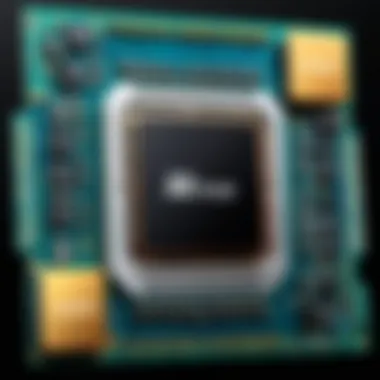Understanding AM4 Socket CPUs: A Comprehensive Guide


Intro
In the realm of computer hardware, understanding the intricacies of CPU architectures is essential for both IT professionals and tech enthusiasts alike. The AM4 socket, developed by AMD, represents a pivotal advance in this field, melding performance with versatility. As we dissect the specifications, compatibility issues, and performance metrics associated with AM4 CPUs, it becomes clear that this architecture is relevant for a variety of applications—ranging from gaming rigs to enterprise-level servers.
This guide will highlight the key features of AM4 socket CPUs, analyze their performance in real-world scenarios, and illuminate the future trends shaping this technology. We aim to provide valuable insights that can enhance system builders' knowledge, aid in decision-making processes, and ultimately serve as a tool for optimizing hardware configurations.
Features Overview
Key Specifications
The AM4 socket architecture is designed to support a range of AMD processors encompassing Ryzen, Athlon, and some A-series CPUs. Here are the key specifications that characterize this socket:
- Socket Type: AM4. Developed for a wide array of socket-compatible CPUs.
- Chipset Variants: Includes B450, X470, B550, X570. Each chipset provides varying levels of performance and features.
- Memory Support: DDR4 memory, with speeds ranging from 2133 MHz to 4400 MHz (OC).
- PCIe 4.0 Compatibility: Available with select chipsets, allowing for faster data transfer rates with compatible graphics cards and storage solutions.
- Thermal Design Power (TDP): Ranges from 35W to 105W, depending on the specific processor model.
Unique Selling Points
What sets the AM4 socket CPUs apart from competitors? There are several unique selling points:
- Backward and Forward Compatibility: The AM4 socket's design allows for seamless upgrades from older CPUs to the latest offerings, ensuring that users can maximize their investment.
- Robust Performance: With its multithreading capabilities and higher core counts, AM4 CPUs deliver superb performance for both gaming and productivity applications.
- Ecosystem Flexibility: Given the variety of chipsets available, users can select a motherboard based on their budget and performance requirements, making AM4 CPUs adaptable for any build.
"The versatility of AM4 socket CPUs is a game-changer for users looking to customize their hardware for specific tasks."
Performance Analysis
Benchmarking Results
In performance benchmarking, AM4 CPUs consistently perform well when compared to both Intel and older AMD architectures. Benchmarks across various applications demonstrate the following:
- In gaming tests, the Ryzen 7 5800X outperforms Intel's Core i7-10700K in most scenarios, offering better frame rates in demanding titles.
- Productivity and content creation tasks show substantial gains, with Ryzen 9 5900X leading in multi-core benchmarks, making it ideal for rendering and video processing.
Real-world Scenarios
When we assess the performance of AM4 CPUs in everyday use, different scenarios yield tangible benefits:
- For gamers, an AM4 CPU can deliver crisp, high frame rates even at 1440p resolution, making it suitable for competitive play.
- In professional environments, AM4 CPUs excel in tasks like software development and data analysis owing to their multi-core capabilities, speeding up compile times.
As we delve into the future, the AM4 architecture is expected to evolve further, aligning with industry trends towards increased core counts and power efficiencies. Understanding these fundamentals not only helps in selecting the right CPU but also enhances overall system performance.
Prolusion to AM4 Socket CPUs
The AM4 socket is a pivotal component in the world of computer architecture, specifically for AMD's product offerings. Understanding the AM4 socket CPUs is essential for IT professionals and tech enthusiasts alike due to the significant impact they have had on performance and compatibility in recent years. This section serves as an introduction to the multifaceted aspects of AM4 socket technologies, covering their specifications, historical development, and relevance in the current landscape of CPUs.
Defining the AM4 Socket
The AM4 socket was introduced in 2016, designed to support a diverse range of processors from AMD, including the Ryzen series and APUs. What distinguishes the AM4 socket is its pin count and layout. It has 1331 pins with a specific configuration that facilitates the connection to multiple types of CPUs. This design not only enables easy integration but also sets the foundation for a variety of performance capabilities across different computing needs.
Beyond its architecture, the AM4 socket is also notable for its backward and forward compatibility. This means that a motherboard designed for an AM4 processor can often support newer models through BIOS updates, extending its utility and lifespan in a rapidly evolving market. For users looking to upgrade, this aspect presents a compelling argument in favor of adopting AM4 CPUs as part of their system builds.
Historical Context and Development


The development of the AM4 socket reflects AMD's strategic shift to reclaim market share from competitors. Prior to AM4, AMD faced significant challenges against Intel’s established dominance. The introduction of the AM4 socket coincided with the launch of the Ryzen processor line, marking a renaissance in AMD's product lineup.
The specifications and technology surrounding the AM4 socket were designed not only to compete but to innovate. The AM4 architecture allowed for significant improvements in multi-threading performance, which was a critical area where AMD sought to make a strong impact.
Over the years, the AM4 socket has undergone various iterations and improvements, adapting to new technologies such as DDR4 RAM and PCIe 4.0, which further bolstered its performance capabilities. The commitment to continuous development has been vital in keeping AMD relevant and competitive in today’s CPU market. The embrace of AM4 technology represents a broader industry trend towards greater performance at accessible price points, highlighting the ongoing evolution of CPU architecture.
"The AM4 socket signifies a major turning point for AMD, as it successfully integrates technological advancements with user needs and market demands."
Through this discussion, it is clear that the AM4 socket CPUs are not only a cornerstone of AMD’s strategy but also a reflection of the changing dynamics within the computer hardware landscape. Understanding these historical nuances is crucial for professionals who aim to leverage AM4 technology in their computing solutions.
Technical Specifications of AM4 CPUs
The technical specifications of AM4 CPUs form the backbone of this architecture's performance capabilities and compatibilities. For IT professionals and tech enthusiasts, these specifications offer a clear understanding of what they can expect from systems built around this socket. Knowing the intricate details can significantly aid in making informed hardware choices. The right specifications not only determine performance but also play a crucial role in upgradability and system longevity.
Pin Count and Socket Design
The AM4 socket features 1331 pins, which facilitates a solid connection between the CPU and the motherboard. This pin count is significant as it helps accommodate a broad range of compatible processors, enhancing flexibility. The design of the AM4 socket allows for easy installation and removal, reducing the likelihood of damage during user handling. Moreover, the socket is designed to support both consumer-grade processors and higher-performance models, giving it an edge over other sockets. The arrangement provides stability and ensures effective heat dissipation, which is essential for high-performance CPU operation.
Supported Processor Types
AM4 is remarkable for its support of a diverse array of processors. It accommodates Ryzen, Athlon, and some APUs, giving users multiple options based on their performance needs and budget constraints. The Ryzen series, particularly, presents a multitude of cores which vastly enhances multitasking capabilities. For instance, the Ryzen 7 and Ryzen 9 offer additional threads compared to their predecessors. This versatility ensures that whether a user is working with standard office applications, gaming, or undertaking intensive workloads, there is a suited processor available within the AM4 lineup.
Chipsets Compatible with AM4
Compatibility with various chipsets is a crucial aspect of the AM4 socket. Several chipsets, including B350, B450, X370, and X570, pair effortlessly with AM4 CPUs. Each chipset offers unique features tailored to different user needs:
- B350: A solid base for budget builds, supporting overclocking.
- B450: Enhances performance with slightly improved features while maintaining affordability.
- X370: Geared towards more advanced users, provides robust overclocking and scaling.
- X570: The top tier in terms of performance and features, including PCIe 4.0 support.
Adapting one of these chipsets allows for modularity and future upgrades, aligning with the needs of any ambitious build. Understanding the chipset landscape is essential for leveraging the full potential of AM4 CPUs.
Performance Characteristics
Performance characteristics are a crucial aspect of understanding AM4 socket CPUs. These characteristics allow IT professionals and tech enthusiasts to assess the capabilities of these processors. By examining performance metrics, we can determine not only how well these CPUs perform under different workloads but also how they stack up against other offerings in the market.
Benchmarking AM4 CPUs
Benchmarking serves as a standardized method for evaluating CPU performance. There are various tools available for benchmarking, such as Cinebench, Geekbench, and PassMark. These tools measure different aspects like single-core and multi-core performance, offering valuable insights.
Key Points of Benchmarking:
- Single-Core Performance: Important for tasks that require quick processing, such as gaming.
- Multi-Core Performance: Benefits applications that can utilize multiple threads, such as video editing or 3D rendering.
When comparing various AM4 CPUs, it is essential to consider their performance in different scenarios. The Ryzen 9 5900X, for example, consistently ranks high in both single and multi-core benchmarks, making it a favorite among gamers and content creators.
Real-World Application Performance
In addition to synthetic benchmarks, real-world application performance provides a more holistic view of CPU capabilities. This includes factors such as responsiveness and efficiency during everyday tasks, gaming, and creative workloads.
Real-world performance is often determined by evaluating specific applications. For instance:
- In gaming scenarios, the Ryzen 5 3600 is known for delivering solid frame rates across various titles.
- When using software like Adobe Premiere Pro, CPUs from the Ryzen 7 series show significant rendering advantages compared to older models.


Ultimately, how a CPU performs in real-world scenarios can influence user experience, making it an important consideration.
Thermal Performance and Power Consumption
Managing heat and power usage is vital for any CPU. The thermal performance of AM4 CPUs varies across models, impacting both longevity and energy efficiency. An effective cooling solution is necessary to harness full performance, especially in high-load situations.
Considerations:
- TDP Rating: The Thermal Design Power rating indicates how much heat a CPU generates. Higher ratings require more powerful cooling solutions.
- Power Consumption: Efficient power usage can lead to lower electricity bills and less heat generation. Models like the Ryzen 5 5600G balance performance and power efficiency well.
Understanding these aspects helps users make informed decisions based on their specific needs and workloads. It is important to also factor in any necessary cooling systems, as inadequate cooling can lead to throttling and diminished performance.
"Performance is not only about speed but also about efficiency in real-life applications."
In summary, analyzing performance characteristics through benchmarking, real-world applications, and thermal management provides a comprehensive understanding of AM4 socket CPUs, guiding purchasing decisions and system configurations.
Advantages of AM4 Socket CPUs
AM4 socket CPUs bring several advantageous characteristics that make them appealing in today's competitive market for IT professionals and tech enthusiasts. These advantages showcase why many consumers gravitate toward this architecture. From versatility to cost-effectiveness, AM4 processors deliver value and performance that meet various user needs.
Versatility and Upgradability
One notable strength of AM4 socket CPUs is their inherent versatility. This design supports a wide range of processors, including Ryzen 1000 series, 2000 series, 3000 series, and 5000 series CPUs. Such compatibility ensures an extensive upgrade path without needing to replace the motherboard. For instance, a user with a Ryzen 5 1600 can easily upgrade to a Ryzen 9 5900X while keeping the same motherboard. This flexibility allows consumers to adapt to evolving performance requirements without significant investments in new hardware.
Additionally, AM4 supports different chipsets like A320, B350, B450, X370, and X570. This range provides choices based on budget and desired features such as overclocking, PCIe lanes, and additional connectivity options. Such a broad selection can enhance the user experience and overall system performance, making AM4 a preferred choice among professionals seeking customizability in their builds.
Cost-Effectiveness
Another key advantage of AM4 socket CPUs is their cost-effectiveness. Compared to alternatives such as Intel's LGA 1151 or LGA 1200 platforms, AM4 offers competitive pricing for both processors and motherboards. Users can build powerful systems at a reasonable cost, which is essential for budget-conscious tech buyers.
Moreover, with its broadened compatibility, the potential for upgrades can delay the necessity for more extensive expenses. Investing in a platform that supports multiple generations of CPUs enables users to maximize their return on investment. Additionally, many AM4 components are accessible in the second-hand market, creating even more opportunities to save.
Enhanced Features for Gaming and Productivity
When it comes to gaming and productivity, AM4 socket CPUs provide enhanced features that deliver an engaging experience. Many modern AM4 CPUs include advanced technologies such as simultaneous multithreading (SMT), which allows for better handling of concurrent tasks. This capability significantly improves performance in both gaming and productivity applications, making them more efficient.
For gaming specifically, AMD's architecture has demonstrated excellent performance in titles that benefit from multi-core designs. CPUs like Ryzen 5 and Ryzen 7 provide ample power for demanding games while maintaining thermal efficiency. Furthermore, features like Precision Boost and StoreMI technology offer additional performance and improved load times for applications.
"AM4 socket CPUs deliver an exceptional balance of performance and value, especially for users who prioritize both gaming and productivity."
Comparative Analysis with Other Socket Types
A thorough understanding of AM4 socket CPUs involves examining how they compare with other popular socket designs. Competitive analysis is vital for discerning the strengths and weaknesses of various architectures. It aids IT professionals and enthusiasts in making informed decisions regarding upgrades or new builds. Each socket type has specific characteristics that shape compatibility and performance.
AM4 vs. LGA
The LGA 1151 socket, used by Intel, is well-known. It supports several generations of processors including Skylake, Kaby Lake, and Coffee Lake. The primary difference with AM4 lies in the compatibility and variety of chipsets. AM4 supports a broader array of processors from entry-level to high-end. In contrast, LGA 1151 is more limited in its range of supported CPUs, especially regarding future-proofing.
- Power Consumption: AM4 CPUs typically exhibit more efficient power consumption. This is significant for system builders focusing on thermal management.
- Upgradability: While LGA 1151 requires motherboard upgrades for newer generations, many AM4 motherboards support several CPU generations with appropriate BIOS updates.
By focusing on versatility, AM4 offers a compelling case for users prioritizing longevity in their CPU choices.


AM4 vs. LGA
The LGA 1200 socket represents Intel's response to the growing adaptation of leading-edge technologies in processors. It supports the Comet Lake and Rocket Lake families. The comparison here is more nuanced, with both sockets active in the current market.
- Core Counts and Performance: LGA 1200 often features higher core counts, which can benefit some specialized tasks. However, AMD’s AM4 chips perform well in multi-threading tasks thanks to their architecture optimization.
- Compatibility: Like LGA 1151, LGA 1200 requires motherboard changes to adapt to new CPUs. AM4 counters this with a flexible upgrade path.
This aspect of AM4's design promotes an extended lifecycle compared to LGA 1200.
AM4 vs. TRX4
The TRX4 socket caters to AMD’s high-end desktop processors, specifically the Threadripper series. This type of socket is designed for a completely different market segment, emphasizing enterprise-level computing and heavy multitasking capabilities.
- Performance Demand: TRX4 supports more cores and threads, targeting professionals who need potent processing power. If users require extensive computational capacity, TRX4 is likely more suitable.
- Cost Considerations: AM4 setups can be accomplished at a lower cost while still delivering good performance for gaming and standard workloads. Users often find TRX4 systems pricier with components that may exceed their requirements.
"Choosing the right socket type is vital. It determines not just performance, but also future upgrade options and overall system longevity."
By assessing these comparisons, readers can make educated decisions that align with their individual needs, whether in cost, performance, or flexibility.
Future of AM4 Technology
The AM4 socket architecture has significantly influenced the computing landscape since its introduction. As we look towards the future of AM4 technology, several key trends and developments come to the forefront. Understanding these shifts is vital for IT professionals and tech enthusiasts alike, as they define the trajectory of CPU design and compatibility in the coming years.
Trends in CPU Development
The evolution of CPU technology is relentless. Emerging trends in CPU development focus heavily on increased efficiency, better thermal management, and improved multi-core performance. For instance, manufacturers like AMD have been emphasizing performance-per-watt ratios, enabling CPUs that deliver higher speeds without substantial power draw. Moreover, advancements in semiconductor technology, notably reductions in manufacturing processes—from 7nm to 5nm—are pushing the boundaries of what is possible.
Additionally, the rise of heterogeneous computing, where different types of processors work together, is influencing CPU designs. This trend points towards more adaptive and versatile processors that can handle diverse workloads better than ever. The integration of AI capabilities into CPUs also proposes new potential, allowing for real-time adjustments and optimizations based on user behavior.
Potential Successors to AM4
While the AM4 socket has established itself as a strong player in the market, discussions around potential successors are already gaining traction. The introduction of newer socket designs could cater to more advanced processors featuring higher core counts and capabilities. One notable successor being discussed is the AM5 socket, which aims to support even more advanced technologies such as DDR5 RAM and PCIe 5.0, providing enhanced bandwidth for data-intensive applications.
Moreover, the continuous pressure from competing standards will influence the future. As Intel and ARM continue to push boundaries with their own architectures, AMD may need to adapt and innovate further to maintain competitive advantages. New technologies such as chiplet architecture, which allows for better scalability, may become predominant as successors to AM4.
Market Projections for Upcoming Releases
Market projections regarding upcoming CPU releases suggest a robust growth phase for systems utilizing the AM4 socket. Analysts indicate that consumer demand for better performance in gaming and productivity tasks will drive sales of CPUs utilizing the AM4 architecture in the near future. The gaming sector will likely continue to thrive, pushing AMD to focus on enhancing GPU integration within AM4 processors to meet gamer expectations.
Furthermore, as manufacturers roll out their next-generation CPUs, we can expect a significant rise in adoption rates among not just gaming enthusiasts but also professionals requiring powerful computing solutions. With strong backing through software optimizations and hardware developments, projections indicate that AM4 CPUs will enjoy sustained relevance for at least the next few years.
As the technology landscape evolves, so too will the needs of consumers and IT professionals. Keeping abreast of these changes ensures that decision-makers can choose the best components for their requirements.
Culmination
The conclusion section of this article serves a pivotal role in encapsulating the essence of the preceding discussion regarding AM4 socket CPUs. In this part, we reflect on the importance of understanding the nuances of AM4 technology. As technology continues to evolve rapidly, having a thorough comprehension of how AM4 CPUs function is vital for IT professionals and tech enthusiasts alike.
Summary of Key Takeaways
In summary, the AM4 socket is more than just a platform for CPUs; it symbolizes a bridge between versatility and performance in the current market. Below are critical takeaways from this comprehensive guide:
- Broad Compatibility: AM4 supports a wide range of processors, from entry-level to high-performance tiers.
- Future-Proofing Options: The AM4 platform has witnessed continuous development, allowing for upgrades without necessitating an entire system overhaul.
- Competitive Performance: Performance benchmarking illustrates that AM4 CPUs can compete robustly against other socket types in various applications, including gaming and productivity.
The culmination of these points signifies the relevance of AM4 CPUs in both consumer and professional markets.
Final Thoughts on AM4 Socket CPUs
Finally, it's essential to note that while the AM4 socket technology has laid a strong foundation for current computing needs, its future remains promising. With trends toward higher core counts and power efficiency, AM4 CPUs are poised to adapt alongside technological advancements driven by user demands. Industry forecasts hint at potential successors that may enhance existing features or introduce new capabilities, which can cater to evolving workloads.



